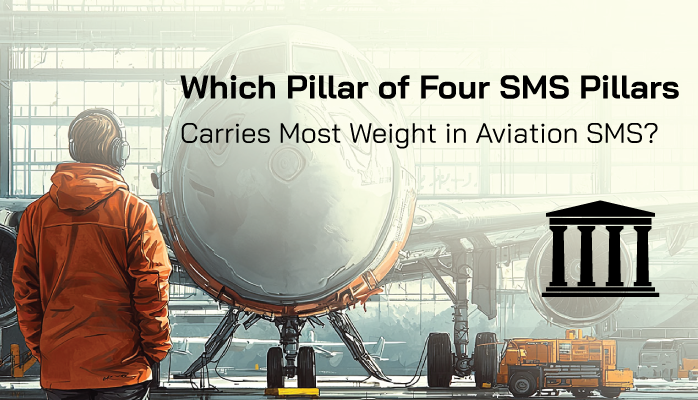All Four Pillars Are Not Created Equal

Aviation safety professionals know that the four pillars of safety management systems are the foundational idea upon which aviation safety management systems (SMS) are based.
- Safety Policy – Defines methods, procedures, and organizational structure
- Safety Risk Management – Looks at the adequacy of, and determines the need for, risk controls, and identifies new hazards
- Safety Assurance – Evaluates the effectiveness of implemented strategies
- Safety Promotion – Aimed at safety training and awareness
Each pillar is extremely important for an ICAO compliant SMS - if one pillar is not adequately addressed, your SMS will undoubtedly have audit findings. Furthermore, all four pillars are required to have an effective SMS. SMS is a process. SMS will work when the process is worked, but one cannot expect to neglect one pillar and still have a performant SMS.
The four pillars of SMS offer an easily recognized structure to aviation SMS. While each pillar (component) is important, that doesn’t mean that all pillars are created equal.
Related Aviation SMS Articles on Four Pillars
- What Are the 4 Pillars of SMS?
- Who Started Four Pillars of Safety Management in Aviation?
- History of Aviation SMS and Four Pillars - With Free Tools
We have seen the most neglect with the Safety Promotion pillar. This is tragic because an operator may spend considerable time:
- Creating safety policy;
- Setting up the safety reporting system;
- Conducting the gap analysis; and
- Providing the initial SMS training.
Yet we frequently see that safety promotion is neglected or seen as "one of those activities we do if the safety team has any spare cycles." Another spur of safety promotion activities may be seen right before an audit. Do you see anything wrong with this picture? Companies with the worst safety cultures spend the least amount of effort on safety promotion activities. This becomes a self-fulfilling prophecy. Employees are not reminded that they should be reporting safety issues. Employees don't report safety issues. Management summarizes that "this SMS fad was just a waste of time."
Which Pillar Is Most Important in Your Aviation SMS?
Don't get me wrong, this isn't about minimizing or maximizing the importance of any pillar. Rather, establishing which pillar carries the most weight is an essential step in:
- Determining where you oversee with the most energy
- The critical point at which an SMS, as a true system, functions
Another way of looking at it is, in which pillar do we find the end goal - where does SMS "come together?"
Defining Safety (or What It Is Not)

Sure, the end goal is providing safety to employees and stakeholders. Maybe you believe the end goal is to stop "The Accident" that we all know is coming. We see minor incidents and close calls every day. The minor incidents are the harbingers of "The Accident."
Aviation safety is probably most often defined as
- Lack of accidents
- Lack of risks
- Safety awareness
I think the problem with looking at safety in these lights is that safety is not static. Safety has many different faces. Its meaning is always changing as the world and environments change.
Case in point, take the above bullet point "lack of accidents." That doesn't necessarily entail a lack of injuries or damaged property - it could simply mean the workforce is adept at skimming by calamity. Or the second bullet "lack of risks," doesn't by any means address risky practices. The third bullet point, "safety awareness", doesn't involve environmental factors.
"Well how about all of the bullet points?" you may say.
But that's not an answer. That's many answers. There is something more fundamental than that and it is the end goal of SMS.
While I think the FAA probably gives the most informed overview definition of what aviation SMS is, I have yet to find a clear, end-goal definition in one sentence.
FAA 14 CFR Part 5 regulations states
the objective of Safety Management Systems (SMS) is
- to proactively manage safety,
- to identify potential hazards,
- to determine risk, and
- to implement measures that mitigate the risk.
The FAA envisions operators being able to use all of the components of SMS to enhance a carrier’s ability to identify safety issues and spot trends before they result in a near-miss, incident, or accident. For this reason, the FAA is requiring carriers to develop and implement an SMS.
Source: Federal Register / Vol. 80, No. 5 / Thursday, January 8, 2015 / Rules and Regulations
Related Articles on Aviation Safety Management Systems
- What Is an Aviation Safety Management System (SMS): SMS 101
- Breaking Down Aviation Safety Management System Parts
- 7 Steps to Put Aviation Safety Management Systems Into Action
The End Goal of SMS
Aviation safety isn't static. It's an evolving process of mitigating risk. The end goal of SMS is therefore also a process that addresses risk in two areas:
- Human behavior
- The environment (including technology)
We can summarize that SMS is a structural process of mitigating risk in and between human behavior and an environment.
SMS should mature over time with this end goal. Immature or static aviation SMS will generally lack management approval or employee participation. For many safety officers, overcoming those hurdles proves to be extremely challenging. Safety cultures require management commitment and consistency to motivate employees to embrace SMS principles and gradually reduce operational risk to as low as reasonably practical (ALARP).
Related Articles on Aviation Safety Cultures
- What Is Safety Culture in the Aviation Industry?
- 5 Characteristics of Effective Aviation Safety Cultures - With Free Survey
- How to Tell Your Safety Culture Needs Help? - With Aviation SMS Resources
Where the Hammer Falls in Aviation Safety

You can't have a movie without a script. And likewise, you can't have an SMS without
- policies and procedures,
- definitions of accountabilities and responsibilities,
- goals and objectives,
- SMS documentation; and
- transparency with just culture.
In other words, the safety policy pillar is a fantastic backbone. However, this is only the first step toward a healthy aviation SMS.
As mentioned, most aviation safety management systems struggle to get to the point of having a healthy safety culture. Safety policies and goals require ongoing reviews and small tweaks rather than major overhaul changes are common during the first years.
Immature safety cultures force safety managers to spend their valuable time and energy trying to get others on board with the aviation SMS rather than focusing on mitigating risks. Laying the groundwork to support healthy safety cultures is the first step, and it's a huge one.
Maintenance beyond this is generally accomplished through the methods of safety assurance, and safety promotion and is fed by Safety Risk Management efforts. SA is an interesting pillar because it acts as a sort of bridge between safety policy and SRM.
But when the hammer falls, it does so with safety risk management. SRM is the ground floor of risk mitigation.
If SRM is not effective, accidents will happen. Every time. Without healthy SRM
- Safety policy pillar activities are essentially useless
- SA activities will not be able to supply data to allow continuous improvement of the SMS.
So here it is, the ultimate goal of mature safety assurance and safety policy components is to function smoothly and efficiently so that a safety officer can spend his/her energy focusing on safety risk management and safety promotion. SRM carries the weight of hazard analysis and risk management processes for human factors and environmental factors.
Healthy SRM processes will be consistently reviewed while receiving robust hazard reporting numbers and auditing data from SA activities. Subsequently, aviation service providers will experience declining numbers of accidents due to operational errors. Furthermore, the safety officer is able to monitor each safety-related hazard more effectively when there are extant processes that continually become refined over time.
Related Articles on Safety Risk Management (SRM) in Aviation SMS
- 4 Elements of Safety Risk Management (SRM)
- Relationship Between Management of Change, SA Process, and SRM Process
- Most Important Activities in Safety Risk Management (SRM)
If Only We Lived in a Perfect World
Unfortunately, we don't.
Like many of you, safety officers have had to deal with in the past or are currently dealing with now, too much of your time is spent playing politics. That gets old - and it's not good for an aviation SMS.
Hopefully, the recent FAA Compliance Policy renovation will have an impact on eroding management resistance and allow safety officers more latitude to do their jobs they way they want.
Where Are You with Your SMS?
Do you really know? Are you on Phase 1 or 2? Here are some questions to ask to get a true understanding of your SMS implementation.
SMS Implementation Phase Surveys to Check SMS Maturity
Risk Management Processes to Review - Two Workflows
Last updated in March 2025.







